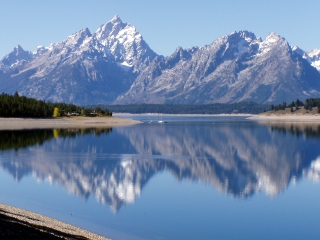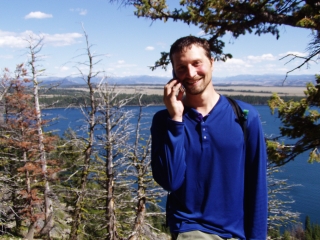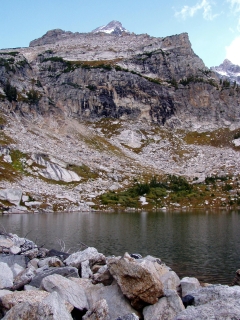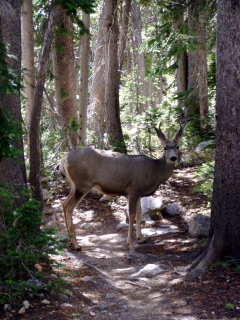NPS Website; Local Website
 WHAT IS IT?
WHAT IS IT?A thin spine of magnificent mountains, twelve rising over 12,000 feet, which stand, unobstructed by foothills, over glacial lakes and rippling meadows.
BEAUTY (10/10)
When we easterners imagine the splendor and the romance of the Rocky Mountains, we are picturing the sharp-toothed peaks of the Tetons. The mountains are never an abstraction; you never have to guess their height. You see everything, their base, their steepness and their snowy peaks. The landscape, from the Snake River to Jackson and Jenny Lake, to the wet meadows, to the sagebrush flats to the naked mountains is extraordinarily beautiful.
HISTORICAL INTEREST (3/10)
We did not learn much history during our stay at the Park. If you are looking for historical fulfillment, the often geographically out of context Indian Art Museum might quench your thirst. John D. Rockefeller helped ensure both the Park’s protection and eternal public access by purchasing a great many acres that are now part of Grand Teton NP.
CROWDS (8/10)
At midday, the lower altitude trails around Jenny, Bradley and Taggert Lakes were all full of hikers, but most greeted us with pleasant smiles and warms hellos. We were all so happy to be hiking in such an astonishing place on perfect weather days.
We started the 13-mile round trip hike to the Forks of Cascade Canyon late. When we reached the 7.5-mile turnaround point, two twentysomething girls were resting near the directional sign leaning on their stuffed-for-a-few-more-backcountry-nights packs. They warmly greeted us; we warned them of the incoming snowstorm. They had not heard of the weather pattern, leading us to believe that they had not seen many people at all during the three days out on the Teton Ridge Trail.
They were so nice and looked so happy and content that we both immediately thought, “we have got to get out in the backcountry soon and away from the easy joys of car camping and day hiking.” We turned around inspired. When we reached Inspiration Point on the return, there was no one else there. We enjoyed the peaceful view of Jenny Lake by ourselves.
 EASE OF USE/ACCESS (2/5)
EASE OF USE/ACCESS (2/5)Grand Teton NP is a destination site and not particularly close to a large population center or an Interstate. Idaho Falls, Idaho, as well as Interstate 15 is 90 miles to the west of the South Entrance. The faux western, nouveau riche and wildly expensive resort town of Jackson, Wyoming is the portal to the park. It stands at the south entrance and has an International Airport.
The east entrance is a long way from nowhere and the north entrance leads only into Yellowstone National Park.
Once you find your way to the Tetons, the Park is accessible. There are numerous lodges on Site and roads take you to the foot of the mountains. Overlooks abound and hiking tails take you everywhere.
CONCESSIONS/BOOKSTORE (5/5)
Whoa. The Visitor Center bookstores, especially at Moose, have oodles of Grand Teton-related books. The kids section takes over ten shelves. A large and extremely lifelike raven puppet enamored Michael and a female octogenarian just off a bus tour. Both placed their hand in the puppet, made raven sounds and pestered their spouse with the toy’s leather beak. Fun in bookstores.
COSTS (3/5)
A $20 vehicle entrance fee is good for a week’s stay at both Yellowstone NP and Grand Teton NP, an incredible bargain given the sheer amount of things to in the Parks’ combined 2.5 million acres. Entry is free with the National Parks Pass.
The National Park Service operates five campgrounds in Grand Teton NP, a total of 913 campsites. All Sites are $12 per night. The Park literature warns that all but the 372-site Gros Ventre campground normally fills by 2:00pm.
We stayed at the popular 50-site, tent-only Jenny Lake campground. This Site normally fills by 8:00am and was at capacity during our stay despite sub-freezing nighttime temperatures and a snowstorm threat.
 RANGER/GUIDE TO TOURIST RATIO (4/5)
RANGER/GUIDE TO TOURIST RATIO (4/5)There are three well-manned Visitor Centers along the Park’s 51-mile north-south road. The Colter Bay Visitor Center included a refreshingly ebullient Ranger working the Backcountry Permit window who eagerly inundated us with more hiking information than we could handle.
During the summer months, there are numerous Ranger-led hikes along the lakes and mountainsides, talks at the Visitor Centers and nighttime campfire programs at the lodges and campgrounds. Planned activities drop off considerably the rest of the year.
TOURS/CLASSES (7/10)
The Colter Bay Visitor Center includes an Indian Arts Museum. The Museum has a tremendous amount of moccasins, beadwork, clothing, you name it, on display. The exhibits show the personal items and artistry of many different Indian tribes, some of which never resided anywhere close to the Tetons. We found it confusing and overwhelming. We find it easier intellectually to travel to Site’s and Museums dedicated only to that areas indigenous tribe. But if you don’t have the luxury of time, the Colter Bay Indian Arts is not a bad alternative.
The Jenny Lake and Moose Visitor Centers center around dinner table-sized topographical maps of the Park. We attended only one Ranger talk, at Moose, which took place around that same map. It was a pointer on hard plastic introduction to the Park and it was crowded. We tried hard, but failed, to nudge our way in to get a view of the map. So we left. We had already spent a few days at the Tetons so we probably were not the aimed demographic.
We did not attend the Ranger classes because we were having such a great time hiking the mountains. We were ably assisted by terrific (and free) map and trail guides provided by the Park. You just have to ask for them. The pamphlets explain many hikes, point of wildlife tidbits and give surprisingly detailed topographical information. The Taggert and Bradley Lakes map even shows the correct number of switchbacks on the way to Amphitheater Lake! While on the hike, Michael eagerly counted down all fourteen.
 FUN (10/10)
FUN (10/10)As if watching the majestic Teton peaks getting closer and closer as we drove straight down from Yellowstone wasn’t exciting enough, by the time we finished talking with the Backcountry Ranger at Colter Bay we were nearly falling over ourselves rushing to get a camping spot, dump our stuff and head right into our first hikes. We found one of the few remaining sites at the beautiful Jenny Lake campground, set up camp and set out while the sun was still shining.
Each walk we took had what Gab likes to call, a “payoff.” Something beautiful that can only be reached by foot: justification for your trek into the canyon or up the hill, a good reason for why you are out of breath. Hidden waterfalls, glacial lakes and a bald eagle were among our payoffs here.
This place is magical. We felt renewed and re-invigorated with each hike and reminded that it was high time to head into the backcountry after talking with the two young girls nearing the end of their trip. We tried to cram as much as we could into the sunny days preceding the ominous weather forecast, but still find ourselves eager for more time in the Park, especially the Teton Ridge Trail.
WOULD WE RECOMMEND? (10/10)
Yes. Yes. Yes. Grand Tetons NP is not as well-known or as crowded as its northern neighbor, but it is just as accessible, just as beautiful, and just as unpredictable when it comes to weather. We strongly recommend checking the forecast before heading into the Tetons. We may not have been so enthralled had the road out been closed because of snow.
TOTAL 62/80
www.usa-c2c.com
© 2004-06